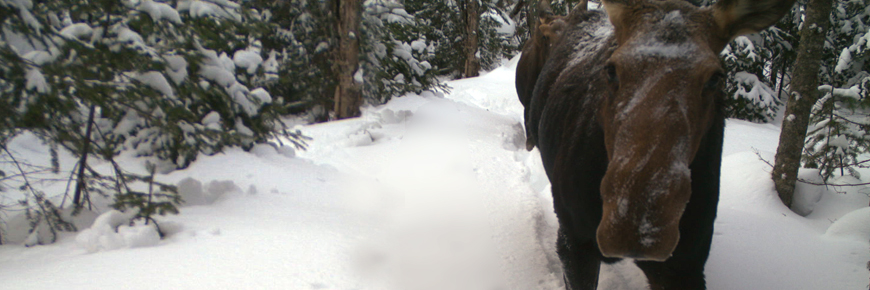
Monitoring moose from the air
Pukaskwa National Park
During the winter, park staff at Pukaskwa National Park hop aboard a helicopter to count moose (Alces alces) from the air. Moose are a measure of forest ecosystem health and have been monitored in the park since 1975. Moose provide an important measure of ecological integrity of the Park; as the largest ungulate and mammal in the Park, they are a key herbivore and prey item for predators such as black bears (Ursus Americana) and grey wolves (Canis lupus). Furthermore, their populations are believed to have an indirect impact to the threatened boreal caribou (Rangifer tarandus caribou); higher numbers of moose on the landscape attract more predators such as wolves who will also prey on caribou.
The population is estimated from aerial surveys conducted during the winter, whereby data is collected using the same standardized protocol that is followed by the Ontario Ministry of Natural Resources and Forestry. These aerial surveys are typically performed every five years. Early winter habitat modelling (based on forest cover data) is used to stratify the park into 25 km2 blocks, in which either a “high” or “low” moose density is expected. In each of these strata, blocks are randomly selected, and surveyors fly in north-south flight lines covering the entire block in search of animals or tracks in the snow. Typically tracks are spotted first, and this leads surveyors to the animals. When animals are found, their location, sex, and age are recorded. Approximately 25% of the park is sampled and the total population for the park is then estimated.
For this monitoring measure, the upper threshold is set at 0.1 moose/ km2, a density believed to be what is required in order to maintain boreal caribou on the landscape. The 2017 moose population was estimated at 0.08 moose/ km2 (or 148 moose in the Park) and is therefore considered good ecological condition. Sex ratio was 1.1 cows per bull and approximately 8% of animals were calves, both results similar to what was observed in historical surveys in the Park. The condition of the moose population has not changed since the last survey and so the population trend is stable.
- Date modified :